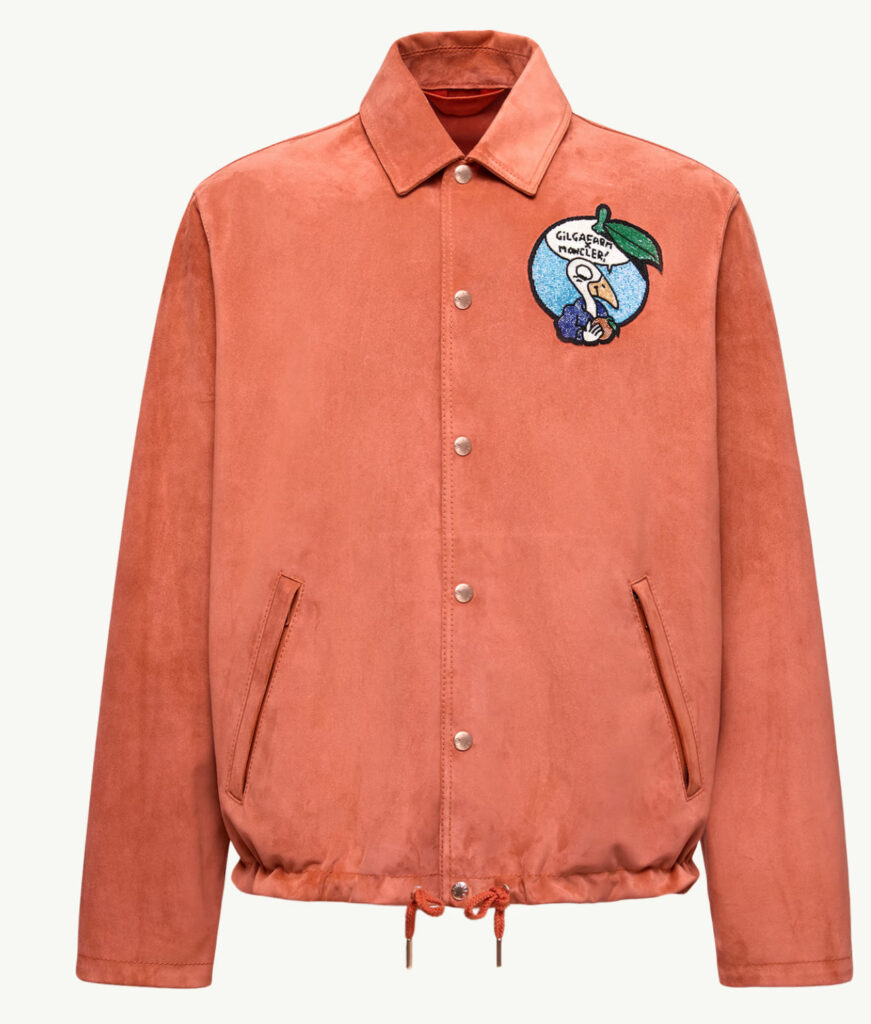

There are garments that conceal. There are garments that protect. And then there are garments that speak—quietly, directly, from a place beyond the margins of fashion. The Navel Suede Shirt Jacket, part of the Moncler x Gilga Farm collaboration led by Donald Glover, belongs wholly to this last category: a piece that neither demands attention nor retreats into anonymity. It exists, rather, in the sacred in-between, where clothing becomes language and silhouette becomes statement.
With Moncler’s technical luxury as its framework, and Gilga’s exploratory art-practice philosophy acting as its compass, the Navel jacket reads as a meditation—on the body, the land, and the emotional textures stitched between the two. This is not just outerwear. This is literature in suede.
A Connection Rooted in Soil and Self
From the outset, the Moncler x Gilga partnership felt different. Not a brand mash-up but a conceptual excavation. While most fashion collaborations begin in aesthetics, Donald Glover’s vision for Gilga began in place—specifically, in the imagined artistic farm at the edge of nowhere and possibility. Gilga is not just a label; it is a creative manifesto. A space for generative slowness. A container for ideas that do not need to explain themselves to market forces.
Moncler, typically associated with alpine gear and luxury streetwear, brought its outerwear expertise to the collaboration. But in this space—Gilga Farm, imagined or real—it traded snow for sand, and insulation for introspection. The Navel Suede Shirt Jacket stands as the central artifact in this transformation. It’s not made to shield from storms, but to accompany moments of pause. It feels like something worn while walking through a vineyard at dusk. Or while writing poetry on an empty train.
Its title, “Navel,” points us inward.
Texture as Topography: The Feel of Suede
Crafted from sand-colored premium suede, the shirt jacket feels like sun-warmed clay in garment form. The suede isn’t overly treated or polished. Instead, it retains a subtle nap—a living texture that shifts with movement and light. This suede doesn’t perform. It breathes. It absorbs gesture. It becomes a record of wear.
The color—somewhere between ochre and bleached sandstone—feels almost archaeological. It belongs to places with no clear borders. Places where land meets memory. There is a quiet intentionality in every fiber, one that resists the flash of urbanity and instead leans into elemental grounding.
The shirt collar is gently oversized, inviting a sense of ease. Not stiff or starched, but soft, sloped—evoking painter’s smocks or chore jackets worn by farmers and thinkers alike. The dual breast pockets echo utility but refuse exaggeration. The flap closures are minimal, their presence more functional than decorative.
Buttoned all the way up, the silhouette offers containment—precise, quiet, intellectual. Worn open, it loosens into something more ritualistic, the sway of suede behaving like desert air. It is neither masculine nor feminine. Neither contemporary nor retro. It is simply felt.
Design As Intuition: Donald Glover’s Signature Minimalism
Donald Glover has never been interested in fashion for spectacle. His aesthetic is tuned to silence, rhythm, improvisation. From Atlanta to Guava Island, his universe favors texture over trope, layering emotional tone over superficial style.
The Navel jacket is cut from the same cloth—figuratively and literally. There are no bold logos, no shout-outs to hype. Instead, there is an inward curve. A breath. The jacket evokes that rare confidence of someone who does not dress to be seen but dresses because they feel something. Something they may not even be able to name.
That’s what makes the design powerful. It trusts the body to complete the story. You can imagine Glover himself in it—barefoot on a hillside, or sitting at an outdoor table with pen in hand. The jacket is not costume; it’s extension. A tool for tuning into time. For shedding signal and listening to static.
Farming the Future: Gilga as Cultural Soil
The Gilga Farm concept is, in many ways, the antithesis of digital culture. Where algorithmic fashion favors immediacy, virality, and uniformity, Gilga Farm grows slowly. It tends to the overlooked. It buries and unearths. It considers space, spirit, and intentional disconnection.
By naming the jacket “Navel,” the designers aren’t referencing naval military or marine aesthetics. They are invoking the navel—the human origin scar, the bodily tether to nourishment and birth. This is not a shirt jacket for war or adventure. It is for remembering. For anchoring. For letting the wind move through your clothes and into your thoughts.
Even the way the garment is styled in campaign imagery—loose trousers, bare feet, soil under the nails—emphasizes this narrative. The models do not pose; they stand. They move slowly. They breathe. Moncler’s performance-wear history meets Glover’s meditative futurism, and the result is not a new category of luxury—it’s a withdrawal from category altogether.
Quiet Radicalism: Wearing the Navel Jacket
To wear the Navel Suede Shirt Jacket is to reject noise. It is not about trending. It is about tracking inner rhythm. It is the type of garment that resists washing, refuses overwearing, and thrives when stored beside books and bare earth.
There is no overt gendering in its cut. No seasonal restriction. No branded choreography. You wear it when you’re alone, and somehow it still feels seen. You wear it at dusk and it feels warmer. You wear it with nothing underneath, and it feels like skin. You wear it with layers, and it becomes shell.
It recalls Japanese wabi-sabi. It echoes the adobe-toned philosophy of Rick Owens’ early desert collections. It sits in quiet relation to The Row’s monastic tailoring, and yet it belongs nowhere except to itself.
The Myth of Moncler, Replanted
Moncler, for all its alpine origins, is not afraid to change altitude. Under Remo Ruffini’s New Luxury strategy and its Moncler Genius program, the brand has embraced modularity—collaborations with JW Anderson, Craig Green, Hiroshi Fujiwara, and now, Donald Glover.
The Gilga capsule may be its most metaphysical offering yet. There’s a reorientation from performance gear toward performance of self. A swapping of city grit for rural calm. A shifting from the vertical (mountains, upward ascension) to the horizontal (fields, rest, soil).
The Navel Suede Shirt Jacket is the cornerstone of this shift. Its silhouette is not about going somewhere—it’s about being somewhere. It’s about being still. And that, in an age of endless speed, is profoundly radical.
Closing the Loop: The Jacket as Dialogue
Fashion is often a monologue. But the Navel jacket starts a conversation—with land, with touch, with solitude. It doesn’t lecture. It listens. It’s not about status but about stillness. There is no urgency in its seams. Only suggestion.
Like Gilga itself, the jacket is unfinished. Not incomplete—but open. It is waiting for the wearer to bring meaning. To move through it. To let it wear in and become a trace of time.
It might gather dust. It might hold the scent of firewood. It might get stained with wine, sweat, or ink. And all of that will make it better. Because this is not a jacket designed to impress. It is a jacket designed to witness.
A shirt jacket called Navel. Born of soil and suede. Designed not to decorate the body, but to hear it.
No comments yet.








